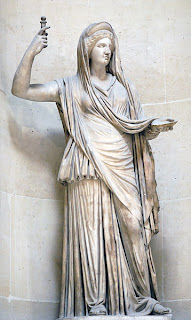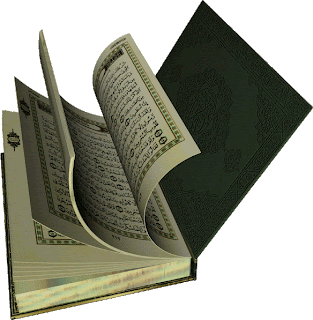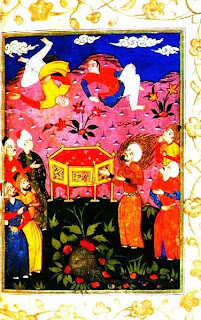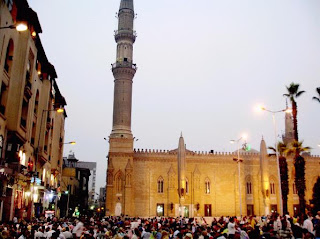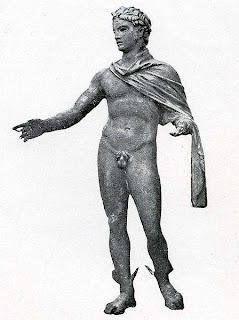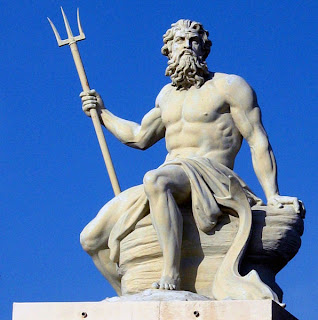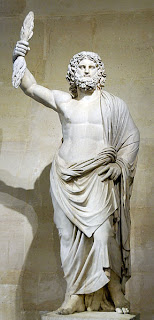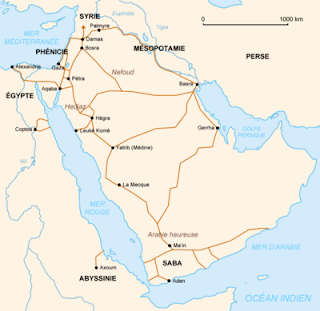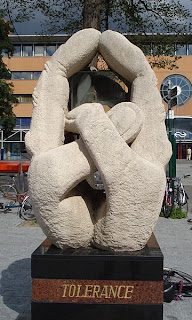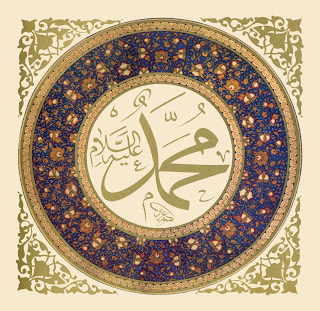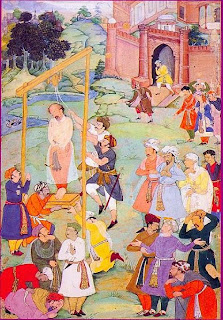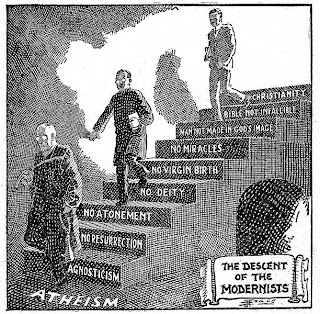Noah Feldman makes a searing case that both politics and religion --
whatever their differences -- are similar technologies, designed to
efficiently connect and manage any group of people.
Description of the religions of the world - Principles and practices, controversies and common features of the famous religions such as Islam, Christianity, Judaisim, Buddhism, confucianism ...
Sunday, November 27, 2011
Tuesday, November 8, 2011
Famous Quotes about God
Famous quotes about God
- I believe God is managing affairs and that He doesn't need any advice from me. With God in charge, I believe everything will work out for the best in the end. So what is there to worry about.
Henry Ford - God places the heaviest burden on those who can carry its weight.
Reggie White - What we are is God's gift to us. What we become is our gift to God.
Eleanor Powell - God loves each of us as if there were only one of us.
St. Augustine - God: The most popular scapegoat for our sins.
Mark Twain - Clearly, God is a Democrat.
Patrick Caddell - People see God every day, they just don't recognize him.
Pearl Bailey - I know God will not give me anything I can't handle. I just wish that He didn't trust me so much.
Mother Teresa - God is a circle whose center is everywhere and circumference nowhere.
Voltaire - God whispers to us in our pleasures, speaks to us in our conscience, but shouts in our pains: It is His megaphone to rouse a deaf world
C.S. Lewis - I am convinced that He (God) does not play dice.
Albert Einstein - They say that God is everywhere, and yet we always think of Him as somewhat of a recluse.
Emily Dickinson - Your talent is God's gift to you. What you do with it is your gift back to God.
Leo Buscaglia - God is an unutterable sigh, planted in the depths of the soul.
Jean Paul Richter
The centrality of God in religion
God is central for all religions
Religion according to Oxford Dictionary is:the belief in and worship of a superhuman controlling power, especially a personal God or godsThere are two major features characterized by all the main religions of the world. The first is the belief in God or gods, a supreme divinity that is
- omnipotent
- and omniscient
The second feature is that followers of all religions believe that the god they worship is the same god for them as well as for all the others.
Saturday, September 17, 2011
Buddhism
Budhism
Buddhism is for some a religion for others, it's a philosophy of life. Buddisim teaches people to reduce suffering by reaching a deep understanding of themselves. It is a way of finding reality. Buddhism is named ahter Gautama Buddha, a man who lived between about 563 and 483 BC. He was a rich prince who gave up everything to work out how best to live. He is considered as an awakened or enlightened teacher who shared his insights to help sentient beings (beings in contrast with buddhahood; sentient beings are characteristically not enlightened, and are thus confined to the death, rebirth, and suffering) end ignorance of dependent origination which is a concept that states that all phenomena are arising together in a mutually interdependent web of cause and effect. This leads to escaping what is seen as a cycle of suffering and rebirth.According to Buddha when people do bad things all they get is evil responses. His teachings started in India and slowly spread, after his death, through most of Asia, to Central Asia, Tibet, Sri Lanka, Southeast Asia, and the East Asian countries of China, Mongolia, Korea, and Japan and have now spread to the west.
Nirvana
Overcoming suffering bis the key principle underlying the praeching of Buddha.- overcoming suffering allows a person to be truly happy.
- if people make good decisions they would be happy and have peace of mind.
- life is imperfect and suufering is inevitable.
- we suffer because of desire, anger and stupidity.
- we could end our suffering by letting go of desires and overcoming anger and stupidity.
- The complete letting go of these negative influences is called Nirvana, meaning "to extinguish", like putting out the flame of a candle.
- Nirvana and enlightenment mean the same thing: to avoid all evil, to do good, to purify one's mind.
Buddhism teaching
- Non-harm and moderation or balance in everything. This refers to a practice of non-extremism: a path of moderation away from the extremes of self-indulgence and self-mortification
- Buddhists often meditate, or think deeply, while sitting in a special or specific way.
- They often chant and meditate for the following reasons:
1. to understand the human heart and mind,
2. to understand the way the world works,
3. to find peace. - The ultimate state of being is Norvana (perfect enlightenment). It is a state wherein it becomes clear that all dualities apparent in the world are delusory.
Three Marks of Existence
- Impermanence:
the Buddhist notion that all compounded or conditioned phenomena (all things and experiences) are inconstant, unsteady, and impermanent. Everything we can experience through our senses is made up of parts, and its existence is dependent on external conditions. Everything is in constant flux, and so conditions and the thing itself are constantly changing - Suffering (Dukkha):
This is a central concept in Buddhism. The word roughly corresponds to a number of terms in English including suffering, pain, unsatisfactoriness, sorrow, affliction, anxiety, dissatisfaction, discomfort, anguish, stress, misery, and frustration. Although the term is often translated as "suffering", its philosophical meaning is more analogous to "disquietude" as in the condition of being disturbed. As such, "suffering" is too narrow a translation with "negative emotional connotations" which can give the impression that the Buddhist view is one of pessimism, but Buddhism seeks to be neither pessimistic nor optimistic, but realistic. In English-language Buddhist literature translated from Pāli, "dukkha" is often left untranslated, so as to encompass its full range of meaning. - Not-self:
Upon careful examination, one finds that no phenomenon is really "I" or "mine"; these concepts are in fact constructed by the mind. In the Nikayas anatta is not meant as a metaphysical assertion, but as an approach for gaining release from suffering. In fact, the Buddha rejected both of the metaphysical assertions "I have a Self" and "I have no Self" as ontological views that bind one to suffering.
Wednesday, August 31, 2011
Islam!
What is islam?
Who is Allah?
Who is Muhammad?
What is the Quran?
What does history say about Islam?
Islamic art and architecture, science and philosophy!
What impact did Islam have on European Renaissance?
Who are the followers of Islam?
Who is Allah?
Who is Muhammad?
What is the Quran?
What does history say about Islam?
Islamic art and architecture, science and philosophy!
What impact did Islam have on European Renaissance?
Who are the followers of Islam?
Monday, August 29, 2011
Goddess Hera, the Queen of Heaven
Hera was the daughter of Cronus and Rhea,. She was the wife and one of three sisters of Zeus in the Olympian pantheon of classical Greek Mythology. She was called the queen of heaven. Her chief function was as the goddess of women and marriage. In Roman mythology, Juno was the equivalent mythical character. The cow, and later, the peacock were sacred to her.
Portrayed as majestic and solemn, often enthroned, and crowned with the polos (a high cylindrical crown worn by several of the Great Goddesses), Hera may bear a pomegranate in her hand, emblem of fertile blood and death and a substitute for the narcotic capsule of the opium poppy.
Hera was known for her jealous and vengeful nature, most notably against Zeus's lovers and offspring, but also against mortals who crossed her, such as Pelias. Paris offended her by choosing Aphrodite as the most beautiful goddess, earning Hera's hatred.
Portrayed as majestic and solemn, often enthroned, and crowned with the polos (a high cylindrical crown worn by several of the Great Goddesses), Hera may bear a pomegranate in her hand, emblem of fertile blood and death and a substitute for the narcotic capsule of the opium poppy.
Hera was known for her jealous and vengeful nature, most notably against Zeus's lovers and offspring, but also against mortals who crossed her, such as Pelias. Paris offended her by choosing Aphrodite as the most beautiful goddess, earning Hera's hatred.
Sunday, August 28, 2011
What is the Ka'ba?
What is the Ka'ba?
Ka'ba is a very important place of worship for Muslims.Who built it?
When was it built?
Where was ka'ba built?
Why?
Thursday, August 25, 2011
Eid ul-Fitr
Eid ul-Fitr (also called Eid al-Fitr, Id-ul-Fitr, or Id al-Fitr) is a hree day celabration observed by Muslims at the end of Ramadan. The holiday celebrates the conclusion of the thirty days of dawn-to-sunset fasting during the entire month of Ramadan. The celebration falls on the first day of the month of Shawwal (the following month after Ramadan.)
Ritulas
- Eid ul-Fitr is celebrated for three days
- In some countries children are bought new clothes and may be given a small sum of money.
- Typically, Muslims wake up relatively early in the morning—always before sunrise— offer Salatul Fajr (the pre-sunrise prayer)
- It is haraam, or forbidden, to fast on the Day of Eid.[8] That is why it is recommended to have a small breakfast (as a sign of not being on a fast on that day)
- It is a Sunnah (Prophetic tradition) that the Sadaqat-ul-fitr, an obligatory charity, is paid to the poor and the needy before performing the ‘Eid prayer by all those adult Muslims who are required to pay Zakat.
- Eid prayer is performed in congregation in open areas like fields, community centers, etc. or at mosques. No adhan (Call to Prayer) or iqama (call) is to be pronounced for this Eid prayer, and it consists of only two rakaʿāt (units of prayer) with an additional six Takbirs.
- The Eid prayer is followed by the khutbah (sermon)
Wednesday, August 24, 2011
Laylat al-Qadr
Laylat al-Qadr
Laylat al-Qadr (also known as the Night of Destiny, Night of Power, Night of Value, the Night of Decree or Night of Measures) is to be found in the last ten odd nights of Ramadan. There is no history in the Qur'an as to when the specific date is.Therefore in the Sunni communities of all the Islamic countries, the Laylat al-Qadar is found to be on the last ten nights of Ramadan.Revelation of the Qur'an
Laylat al-Qadr comemorates the anniversary of the night Muslims believe the revelation of the Qur'an started. In fact, Muslims believe that the revelation occurred in two phases, with the first phase being the revelation in its entirety on Laylat Al-Qadr to Gabriel in the lowest heaven, and then the subsequent verse-by-verse revelation to Prophet Muhammad by the angel Gabriel.Customs
Muslims often pray extra prayers on this day, particularly the night prayer. They awake, pray, and hope God will give them anything they may desire on this night. They occupy themselves with the remembrance of God, performing voluntary prayers and studying the Qur'an, day and night, apart from the obligatory prayers which they perform with the congregationIn the Qur'an
We have indeed revealed this (Message) in the Night of Power:
And what will explain to thee what the night of power is?
The Night of Power is better than a thousand months.
Therein come down the angels and the Spirit by Allah's permission, on every errand:
Peace!...This until the rise of morn!
—Sura 97 (Al-Qadr), āyāt 1-5
Tuesday, August 16, 2011
Sourat Hud
Hud and his people in the Qur'an
The following Sourah is about the prophet Hud and His people ʿĀd. The presentaion includes the text in Arabic and its translation in English.
Click here to know more about the story of Ad and the prophet Hud.
ʿĀd People
The Qur'an mentioned the story of the prohet Hud and his people ʿĀd (or Aad.) This people is believed to have lived in Ancient Arabia. The eleventh chapter of the Qur'an, Hud, is named after the prohet sent to ʿĀd. According to the Qur'an ʿĀd people lived in Arabia. In the 1980s there was the discovery of what is thought to be Ubar, mentioned in the Qur'an as Iram, which is believed to have been the capital of ʿĀd. This was discovered in the area near eastern Yemen and western Oman.
Hud, even in childhood, remained consistent in prayer to God. It is related through exegesis that Hud's mother, a pious woman who had seen great visions at her son's birth, was the only person who encouraged Hud in his worship. Thus, the Lord raised up Hud as a prophet for the ʿĀd people.
When Hud started preaching and invited his people to the worship of only the true God and when he told them to repent for their past sins and ask for mercy and forgiveness, the ʿĀd people began to revile him and wickedly began to mock God's message.After a log time of preaching, the majority of Hud's people refused to pay any notice to his teachings and they kept ignoring and mocking all he said. As their aggression, arrogance and idolatry deepened, God, after plenty of warning, sent a thunderous storm to finish the wicked people of ʿĀd once and for all through a destructive storm.
Historical context
Hud is said too have been fourth in generation from Noah, his father being Uz, who was the son of Aram, who was the son of Shem, who was the son of Noah. Although Hud, at times, is identified with Eber of the Old Testament, his true Biblical identity remains uncertain. Hud is believed to have lived in Arabia before even the coming of Ishmael and Hagar.The story of Aad People
The people of ʿĀd were extremely powerful and wealthy and they built countless buildings and monuments to show their power. However, the ʿĀd people became arrogant and forsook God and began to adopt idols for worship, including three idols named Samd, Samud and Hara.Hud, even in childhood, remained consistent in prayer to God. It is related through exegesis that Hud's mother, a pious woman who had seen great visions at her son's birth, was the only person who encouraged Hud in his worship. Thus, the Lord raised up Hud as a prophet for the ʿĀd people.
When Hud started preaching and invited his people to the worship of only the true God and when he told them to repent for their past sins and ask for mercy and forgiveness, the ʿĀd people began to revile him and wickedly began to mock God's message.After a log time of preaching, the majority of Hud's people refused to pay any notice to his teachings and they kept ignoring and mocking all he said. As their aggression, arrogance and idolatry deepened, God, after plenty of warning, sent a thunderous storm to finish the wicked people of ʿĀd once and for all through a destructive storm.
The verses of the story
We sent to the people of 'Ad their brother Hud, who said: "O my people, worship God; you have no other god but He. (As for the idols,) you are only inventing lies.
O my people, I ask no recompense of you for it: My reward is with Him who created me. Will you not, therefore, understand?
O my people, beg your Lord to forgive you, and turn to Him in repentance. He will send down rain in torrents for you from the skies, and give you added strength. So do not turn away from Him as sinners."
They said: "O Hud, you have come to us with no proofs. We shall not abandon our gods because you say so, nor believe in you.
All we can say is that some of our gods have smitten you with evil." He replied:" I call God to witness, and you be witness too, that I am clear of what you associate (in your affairs)
Apart from Him. Contrive against me as much as you like, and give me no respite.
I place my trust in God who is my Lord and your Lord. There is no creature that moves on the earth who is not held by the forelock firmly by Him. Verily the way of my Lord is straight.
If you turn away, then (remember) I have delivered to you the message I was sent with. My Lord will put other people in your place, and you will not be able to prevail against Him. Indeed my Lord keeps a watch over all things."
—Qur'an, sura 11 (Hud), ayah 50-57[7]
So when they saw it as a cloud advancing towards their valleys, they said: "This is just a passing cloud that will bring us rain." "No. It is what you were trying to hasten: The wind which carries the grievous punishment!
It will destroy everything at the bidding of its Lord." So in the morning there was nothing but their empty dwellings to be seen. That is how We requite the sinners.
—Qur'an, sura 46 (Al-Ahqaf), ayah 24-25
Tuesday, August 2, 2011
Ramadan
Ramadan
Ramadan is the ninth month of the Islamic calendar, which lasts 29 to 30 days. In this month Muslims fast during the daylight hours, refraining from eating, drinking and sexual intercourse. It is intended to teach Muslims about patience, spirituality, humility and submissiveness to God. Muslims fast for the sake of God (Allah) and to offer more prayer than usual.Date
Compared to the solar calendar, the dates of Ramadan vary, moving backwards by about eleven days each year depending on the moon; thus, a person will have fasted every day of the calendar year in 34 years' time.Hilāl (the crescent) is typically a day (or more) after the astronomical new moon. Since the new moon indicates the beginning of the new month, Muslims can usually safely estimate the beginning of Ramadan.
There are many disagreements each year however, on when Ramadan starts. This stems from the tradition to see the moon (Hilāl = the crescent) with the naked eye and as such there are differences for countries on opposite sides of the globe. More recently however, some Muslims try to use astronomical calculations to avoid this confusion.
Revelation of the Qur'an
Muslims believe Ramadan to be an auspicious month for the revelations of God to humankind, being the month in which the first verses of the Qur'an were revealed to the Islamic prophet, Muhammad. That was in Laylat al-Qadr (also called the Night of Power, the Night of Destiny, Night of Value, the Night of Decree or Night of Measures)In surah Al-Qadr Allah clearly states:
"Surely We revealed it (the Holy Quran) on the grand night. And what will make you comprehend what the grand night. The grand night is better than a thousand months. The angels and Gabriel descend in it by the permission of their Lord for every affair, Peace! It is till the break of the morning." Holy Quran (97:1-5)
Fasting in other religions
Before Islam, fasting was part and parcel of other religions such as Judaism and Christianity."O ye who believe! Fasting is prescribed to you as it was prescribed to those before you, that ye may (learn) self-restraint," Al-Baqara (The Cow) 2:183
Who is permitted not to fast?
Those who are sick, elderly, or on a journey, and women who are pregnant or nursing are permitted to break the fast and make up an equal number of days later in the year. If they are physically unable to do this, they must feed a needy person for every day missed. Children begin to fast (and to observe the prayer) from puberty, although many start earlier.In the Qur'an:
(Fasting) for a fixed number of days; but if any of you is ill, or on a journey, the prescribed number (Should be made up) from days later. For those who can do it (With hardship), is a ransom, the feeding of one that is indigent. But he that will give more, of his own free will,- it is better for him. And it is better for you that ye fast, if ye only knew.
Al-Baqara (The Cow) 2:184
Friday, June 3, 2011
Is Jesus God for muslims?
Jesus Christ and Islam
Is Jesus God f? What's his position in the islamic beliefs? How is he viewed by Muslims?While Christians traditionally believe that Jesus of Nazareth was born of a virgin, performed miracles, founded the Church, rose from death, and ascended into heaven, from which he will return and while the majority of Christians worship Jesus as the incarnation of God the Son, one of three divine persons of a Trinity, in Islam, Jesus is respected and valued in a high place like any other prophet. But he is not considered to be the Son of God or God incarnate. Here are some basic islamic beliefs about Jesus in Islam.
- Jesus Christ is considered to be a Messenger of God and the Messiah who was sent to guide the Children of Israel with a new scripture, Gospel.
- The Qur'an (Koran), considered by Muslims to be God's final and authoritative revelation to mankind, mentions Jesus twenty-five times.
- The Qur'an states that Jesus was born to Mary as the result of virginal conception, a miraculous event which occurred by the decree of Allah.
- To aid in his ministry to the Jewish people, Jesus was given the ability to perform miracles, all by the permission of God rather than of his own power.
- According to the popular opinion and Muslim traditions, Jesus was not crucified but instead, he was raised up by God unto the heavens. This "raising" is understood to mean through bodily ascension. However, the Qur'an speaks of Jesus' death in Sura Al Imran 3:54 in the original Arabic (tawaffa = Cause to die). See also Sura 5:117.
- Islam rejects the Christian view that Jesus was God incarnate or the son of God, that he was ever crucified or resurrected, or that he ever atoned for the sins of mankind.
- The Qur'an says that Jesus himself never claimed any divinity, and it furthermore indicates that Jesus will deny having ever claimed divinity at the Last Judgment, and God will vindicate him.
- The Qur'an emphasizes that Jesus was a mortal human being who, like all other prophets, had been divinely chosen to spread God's message. Islamic texts forbid the association of partners with God, emphasizing a strict notion of monotheism.
More on Jesus in Islam On Wikipedia
Wednesday, May 25, 2011
Twelve Olympians
The Twelve Olympians
The ancient Greeks had a list of twelve deities who were the principal gods and godesses of the Greek pantheon. They were called Olympian because they resided in Mount Olympus. These Twelve Olympians had a prominent role in the Greek mytholgy. The Twelve Olympians gained their supremacy in the world of gods after Zeus led his siblings to victory in war with the Titans.
The following is a list of the Twelve Olympians: gods and goddesses
The ancient Greeks had a list of twelve deities who were the principal gods and godesses of the Greek pantheon. They were called Olympian because they resided in Mount Olympus. These Twelve Olympians had a prominent role in the Greek mytholgy. The Twelve Olympians gained their supremacy in the world of gods after Zeus led his siblings to victory in war with the Titans.
The following is a list of the Twelve Olympians: gods and goddesses
The list of gods and goddesses
| Deity | Description |
|---|---|
| Aphrodite | Goddess of love and beauty. Although married to Hephaestus she had many lovers, most notably Ares. She was depicted as a beautiful woman usually accompanied by her son Eros. Her symbols include the rose, scallop shell, and myrtle wreath. Her sacred animal is the dove. |
| Apollo | God of music, healing, plague, prophecies, poetry, and archery; associated with light, truth and the sun. He is Artemis's twin brother and Hermes elder brother, and son of Zeus and Leto. He was depicted as a handsome, beardless youth with long hair and various attributes including a laurel wreath, bow and quiver, raven, and lyre. Apollo's sacred animal are red cattle. |
| Ares | God of war, bloodlust, violence, manly courage, and civil order. The son of Zeus and Hera, he was depicted as either a mature, bearded warrior dressed in battle arms, or a nude beardless youth with helm and spear. His attributes are golden armour and a bronze-tipped spear. His sacred animals are the vulture, venomous snakes, alligators, and dogs. |
| Athena | Goddess of wisdom, warfare, battle strategy, heroic endeavour, handicrafts and reason. The daughter of Zeus and Metis, she was born from Zeus's head fully-formed and armoured. She was depicted crowned with a crested helm, armed with shield (Aegis), which holds Medusa's head to paralyze her enemies who looked at it and a spear.. Her symbols include the aegis and the olive tree. She is commonly shown accompanied by her sacred animal, the snowy owl. |
| Demeter | Goddess of fertility, agriculture, horticulture, grain and harvest. Demeter is a daughter of Cronus and Rhea and sister of Zeus, by whom she bore Persephone. She was depicted as a mature woman, often crowned and holding sheafs of wheat and a torch. Her symbols are the Cornucopia (horn of plenty), wheat-ears, the winged serpent and the lotus staff. Her sacred animals are pigs and snakes. |
| Dionysus | God of wine, parties and festivals, madness, civilization, drunkenness and pleasure. He was depicted in art as either an older bearded god or a pretty effeminate, long-haired youth. His attributes include the thyrsus (a pinecone-tipped staff), drinking cup, grape vine, and a crown of ivy. Animals sacred to him include dolphins, serpents, tigers, panthers, and donkeys. A later addition to the Olympians, in some accounts he replaced Hestia. |
| Hades or Pluto | King of the Underworld and god of the dead and the hidden wealth of the Earth. His consort is Persephone and his attributes are the key of Hades, the Helm of Darkness, and the three-headed dog, Cerberus. The screech owl was sacred to him. Despite being the son of Cronus and Rhea and the elder brother of Zeus, as a chthonic god he is only rarely listed among the Olympians. The name Pluto became more common in the Classical period with the mystery religions and Athenian literature. |
| Hephaestus | Crippled god of fire, metalworking, stonemasonry, sculpture and volcanism. The son of Hera by parthenogenesis, he is the smith of the gods and the husband of the adulterous Aphrodite. He was usually depicted as a bearded man holding hammer and tongs—the tools of a smith—and riding a donkey. His symbols are the hammer, tongs, and anvil. His sacred animals are the donkey, the guard dog and the crane. When he was born, he was thrown off of Mount Olympus by Hera as he was considered ugly. |
| Hera | Queen of marriage, women, childbirth, heirs, kings and empires. She is daughter of Cronus and Rhea. She was usually depicted as a beautiful woman wearing a crown and veil and holding a royal, lotus-tipped staff. Her sacred animals are the heifer, the lion, the peacock, and the cuckoo. |
| Hermes | God of travel, messengers, trade, thievery, cunning wiles, language, writing, diplomacy, athletics, and animal husbandry. He is the messenger of the gods, a psychopomp who leads the souls of the dead into Hades' realm, and the son of Zeus and Maia. He was depicted either as a handsome and athletic beardless youth, or as an older bearded man. His attributes include the herald's wand or caduceus, winged sandals, and a traveler's cap. His sacred animals are the tortoise, the ram, and the hawk. |
| Artemis | Virgin goddess of the hearth, home and cooking. She is a daughter of Rhea and Cronus and sister of Zeus. She was depicted as a modestly veiled woman, whose symbols are the hearth and kettle. |
| Poseidon | God of the sea, rivers, floods, droughts, storms, earthquakes, and horses; known as the "Earth Shaker" or "Storm Bringer". He is a son of Cronus and Rhea and brother to Zeus and Hades. |
| Zeus | King of the gods and ruler of Mount Olympus; god of the sky and thunder. Youngest child of the Titans Cronus and Rhea |
Hermes
God of travel, messengers, trade, thievery, cunning wiles, language, writing, diplomacy, athletics, and animal husbandry. He is the messenger of the gods, a psychopomp who leads the souls of the dead into Hades' realm, and the son of Zeus and Maia. He was depicted either as a handsome and athletic beardless youth, or as an older bearded man. His attributes include the herald's wand or caduceus, winged sandals, and a traveler's cap. His sacred animals are the tortoise, the ram, and the hawk.
Hermes is the great messenger of the gods in Greek mythology and additionally a guide to the Underworld. Hermes was born on Mount Cyllene in Arcadia. An Olympian god, he is also the patron of boundaries and of the travelers who cross them, of shepherds and cowherds, of the cunning of thieves, of orators and wit, of literature and poets, of athletics and sports, of weights and measures, of invention, and of commerce in general.
Besides, Hermes is a messenger from the gods to humans, sharing this role with Iris. An interpreter who bridges the boundaries with strangers is a hermeneus. Hermes gives us our word "hermeneutics", the study and theory of interpretation. In Greek a lucky find was a hermaion. Hermes delivered messages from Olympus to the mortal world. He wears shoes with wings on them and uses them to fly freely between the mortal and immortal world. Hermes was the second youngest of the Olympian gods, being born before Dionysus.
In the fully-developed Olympian pantheon, Hermes was the son of Zeus and the Pleiade Maia, a daughter of the Titan Atlas. Hermes' symbols were the rooster and the tortoise, and he can be recognized by his purse or pouch, winged sandals, winged cap, and the herald's staff, the kerykeion. The night he was born he slipped away from Maia and stole his elder brother Apollo's cattle.*
More on Hermes on wikipedia
Hermes is the great messenger of the gods in Greek mythology and additionally a guide to the Underworld. Hermes was born on Mount Cyllene in Arcadia. An Olympian god, he is also the patron of boundaries and of the travelers who cross them, of shepherds and cowherds, of the cunning of thieves, of orators and wit, of literature and poets, of athletics and sports, of weights and measures, of invention, and of commerce in general.
Besides, Hermes is a messenger from the gods to humans, sharing this role with Iris. An interpreter who bridges the boundaries with strangers is a hermeneus. Hermes gives us our word "hermeneutics", the study and theory of interpretation. In Greek a lucky find was a hermaion. Hermes delivered messages from Olympus to the mortal world. He wears shoes with wings on them and uses them to fly freely between the mortal and immortal world. Hermes was the second youngest of the Olympian gods, being born before Dionysus.
In the fully-developed Olympian pantheon, Hermes was the son of Zeus and the Pleiade Maia, a daughter of the Titan Atlas. Hermes' symbols were the rooster and the tortoise, and he can be recognized by his purse or pouch, winged sandals, winged cap, and the herald's staff, the kerykeion. The night he was born he slipped away from Maia and stole his elder brother Apollo's cattle.*
More on Hermes on wikipedia
Tuesday, April 26, 2011
Islam in a few words!
What is Islam?
Is it a religion of blood?Do you associate it with terror?
Do you think it's a weird religion?
Do you think Muslims revere a different kind of God?
Do you think that Muslims don't believe in Jesus or Moses?
See the presentation!!!
Thursday, April 21, 2011
Artemis
Virgin goddess
Virgin goddess of the hearth, home and cooking. She is a daughter of Rhea and Cronus and sister of Zeus. She was depicted as a modestly veiled woman, whose symbols are the hearth and kettle. In some accounts, she gave up her seat as one of the Twelve Olympians to tend to the sacred flame on Mount Olympus for Dionysus.In mythology
Artemis was one of the most widely venerated of the Ancient Greek deities. Some scholars believe that the name, and indeed the goddess herself, was originally pre-Greek. In the classical period of Greek mythology, Artemis was often described as the daughter of Zeus and Leto, and the twin sister of Apollo. She was the Hellenic goddess of the hunt, wild animals, wilderness, childbirth, virginity and young girls, bringing and relieving disease in women. She was often depicted as a huntress carrying a bow and arrows. The deer and the cypress were sacred to her. In later Hellenistic times, she even assumed the ancient role of Eileithyia (the Cretan goddess adopted into ancient Greek religion and myth as the goddess of childbirth and midwifery) in aiding childbirth.Artemis later became identified with Selene, a Titaness who was a Greek moon goddess, sometimes depicted with a crescent moon above her head. She was also identified with the Roman goddess Diana, with the Etruscan goddess Artume, and with the Greek or Carian goddess Hecate
Poseidon
Earth Shaker and Storm Bringer
God of the sea, rivers, floods, droughts, storms, earthquakes, and horses; known as the "Earth Shaker" or "Storm Bringer". He is a son of Cronus and Rhea and brother to Zeus and Hades. In classical artwork, he was depicted as a mature man of sturdy build with a dark beard, and holding a trident. The horse and the dolphin are sacred to him.Worship
In his benign aspect, Poseidon was seen as creating new islands and offering calm seas. When offended or ignored, he supposedly struck the ground with his trident and caused chaotic springs, earthquakes, drownings and shipwrecks. Sailors prayed to Poseidon for a safe voyage, sometimes drowning horses as a sacrifice; in this way, according to a fragmentary papyrus, Alexander the Great paused at the Syrian seashore before the climacteric battle of Issus, and resorted to prayers, "invoking Poseidon the sea-god, for whom he ordered a four-horse chariot to be cast into the waves."Zeus the king of gods
The king of gods
Zeus is the son of Cronus and Rhea. He is considered the king of the gods and the ruler of Mount Olympus. He overthrew Cronus, his father. The latter swallowed all his children as soon as they were born. But Rhea fled to an island, Crete, where she gave birth to Zeus. In Greek mythology Zeus was raised by a gaot named amalthea. With the help of the Olympians Zeus Overthrew his father and became the god of the sky, weather, thunder, law, order, and fate.Erotic Escapades
In most traditions he was married to Hera. According to the Iliad, he is the father of Aphrodite by Dione. He is known for his erotic escapades. These resulted in many godly and heroic offspring, including Athena, Apollo and Artemis, Hermes, Persephone (by Demeter), Dionysus, Perseus, Heracles, Helen, Minos, and the Muses (by Mnemosyne); by Hera, he is usually said to have fathered Ares, Hebe and Hephaestus.Depiction
His symbols are the thunderbolt, eagle, bull, and oak. In addition to his Indo-European inheritance, the classical "cloud-gatherer" also derives certain iconographic traits from the cultures of the Ancient Near East, such as the scepter. Zeus is frequently depicted by Greek artists either as:- standing, striding forward, with a thunderbolt leveled in his raised right hand,
- or seated in majesty.
(see the picure)
Sunday, April 10, 2011
The Need for Faith
The atheist view
Atheism is the disbelief in the existence of God or gods. Atheists argue that there is no need for religion. For example, Marxists stand on the basis of philosophical materialism, which rules out the existence of any supernatural entity, or anything outside or "above" nature. There is, in fact, no need for any such explanation for life and the universe. Nature furnishes its own explanations and it furnishes them in great abundance.
Likewise Freud tried to attack the roots of organized religions. Freud contends:
"Religion is an illusion and it derives its strength from the fact that it falls in with our instinctual desires." --Sigmund Freud, New Introductory Lectures on Psychoanalysis,1933.
"Religion is comparable to a childhood neurosis." --Sigmund Freud, The Future of an Illusion, 1927
Need for faith
It is, however, worth noting that even these ideologies developed into new belief systems themselves. For instance when communism was exported to other countries, it was preached with the same commitment and fervor that characterizes preaching and propagation of religion.This need for a belief system is a deep rooted one in human nature. We are born with an innate need for faith. For what is the opposite of faith but despair and hopelessness. Faith can stem from different things including ideologies and religion.
Believers think that even an atheist has faith, no matter how much he or she might deny it. Human beings need to have faith. Mankind is not as self-sufficient as many would like to believe..We are extremely dependent on many things despite our denials.
Believers think that even an atheist has faith, no matter how much he or she might deny it. Human beings need to have faith. Mankind is not as self-sufficient as many would like to believe..We are extremely dependent on many things despite our denials.
Wednesday, April 6, 2011
State of Faith in the World of Today
Faith
Faith is a potent power in the world of today in spite of all the modernization that has occured world wide. The need of faith in the lives of human beings is still strong and religious vitality across the globe shows no signs of diminishing in the near future.Globalization and faiths
This video examines the demographically extensive reach of faiths and the publicly intensive expression of these faiths around the world in a time of gloablization.Monday, April 4, 2011
Good Friday and Jesus Crucifixion
Good Friday
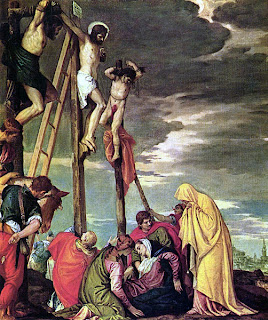 Good Friday also called Holy Friday or Great Friday, is a religious holiday observed primarily by Christians commemorating the crucifixion of Jesus Christ and his death at Calvary or Golgotha, the site, outside of ancient Jerusalem’s early 1st century walls. The celebration is observed during Holy Week as part of the Paschal Triduum , the period of three days from Holy Thursday to Easter Day. The holiday is celebrated on the Friday preceding Easter Sunday, and may coincide with the Jewish observance of Passover.
Good Friday also called Holy Friday or Great Friday, is a religious holiday observed primarily by Christians commemorating the crucifixion of Jesus Christ and his death at Calvary or Golgotha, the site, outside of ancient Jerusalem’s early 1st century walls. The celebration is observed during Holy Week as part of the Paschal Triduum , the period of three days from Holy Thursday to Easter Day. The holiday is celebrated on the Friday preceding Easter Sunday, and may coincide with the Jewish observance of Passover.The Crucifixion of Jesus is believed to have occured on a Friday. The estimated year of Good Friday is AD 33 or AD 34
The Christian account of Jesus crucifixion
The Jewish high priests accused Jesus of blasphemy and sentenced him to death. Because the Jews did not have the right to have a man killed without the approval of the Roman governor, they had to take Jesus to Pontius Pilate. Even though Pilate found him innocent, he feared the crowds and let them decide Jesus' fate. The Jewish chief priests decided to crucify him.Jesusu was publicly whipped and punished before crucifixion. Then he was taken to Golgotha where he would be crucified. A mixture of vinegar, gall, and myrrh was offered to him. This drink was said to alleviate some of the suffering, but Jesus refused to drink it. Stake-like nails were driven through his wrists and ankles, fastening him to the cross where he was crucified between two convicted criminals. On the cross Jesus hung for his final agonizing breaths, a period that lasted about six hours bearing the crowds insults and scoffing. Jesus spoke to his mother Mary and the disciple John from the cross. He also cried out to his father,
"My God, my God, why have You forsaken Me?"Various supernatural events accompany the crucifixion , including darkness, an earthquake, and (in Matthew) the resurrection of saints. Following Jesus' death, his body was removed from the cross and buried in a rock-hewn tomb. According to Christian tradition, Jesus then rose from the dead three days later.
The meaning of Jesus Christ's Day for Christians
Christians believe that Jesus' death on the cross was a knowing and willing sacrifice because he did not mount a defense in his trials. This was undertaken as an "agent of God" to atone for humanity's sin and make salvation possible. That's why Christians have made the crucifix, or cross, one of the defining symbols of Christianity.Islamic account of Jesus Christ's Day.
Muslims believe Jesus was raised to heaven alive by God. The Qur'an states that he was not crucified or killed but was raised. Muslims also believe that Jesus will return before the end of time. This is the verse which expalins all this in the Qur'an:That they said (in boast), "We killed Christ Jesus the son of Mary, the Messenger of Allah";- but they killed him not, nor crucified him, but so it was made to appear to them, and those who differ therein are full of doubts, with no (certain) knowledge, but only conjecture to follow, for of a surety they killed him not:-
Nay, Allah raised him up unto Himself; and Allah is Exalted in Power, Wise;-
—Qur'an, sura 4 (An-Nisa) ayat 157-158
Labels:
Abrahamic,
Christianity,
Religious celebrations
Arabian pre-Islamic beliefs and gods
Jahiliyyah
Arabian pre-islamic beliefs refer to the the beliefs of the Arabs in the era prior to Islam. This era is also called Jahiliyyah (Arabic: جاهلية). It is an Islamic concept of "ignorance of divine guidance" or "the state of ignorance of the guidance from God" or "Days of Ignorance". It refers to the condition Arabs found themselves in pre-Islamic Arabia, i.e. prior to the revelation of the Qur'an to Muhammad. During that period the Kaaba of Mecca was covered in symbols representing the myriad demons, djinn, demigods, or simply tribal gods and other assorted deities which represented the polytheistic Culture of Pre-Islamic Arabia. The following are the worshiped and idolized gods and the goddesses.The Ancient Arabian gods and goddesses
Arabs in the pre-islamic era were polytheists. They worshiped and venerated many gods and godesses that they kept in the kaaba. The most important of them was. The Father, Hubal (Arabic: هبل). He was regarded as the chief god of gods and the most notable one, the idol of Hubal was near the Kaaba in mecca and was made of red agate, and shaped like a human, but with the right hand broken off and replaced with a golden hand.In addition to Hubal, there were three godesses.
- Allāt (Arabic: اللات) or Al-Lāt was a Pre-Islamic Arabian goddess who was one of the three chief goddesses of Mecca. She is mentioned in the Qur'an (Sura 53:19)
- Al-‘Uzzá (Arabic: العزى) "The Mightiest One" or "The strong" was an Arabian fertility goddess who was one of the three chief goddesses of Mecca, Arabs only call upon her or Hubal for protection and victory before any war.
- Manāt (Arabic: مناة) who Arabs believed Manāt to be the goddess of fate, The Book of Idols describes her as the most ancient of all these idols. The Arabs used to name their children 'Abd-Manāt and Zayd-Manāt. Manāt was erected on the seashore in the vicinity of al-Mushallal in Qudayd, between Medina and Mecca. All the Arabs used to venerate her and sacrifice before her. The Aws and the Khazraj, as well as those Arabs among the people of Yathrib and other places who took to their way of life, were wont to go on pilgrimage and observe the vigil at all the appointed places, but not shave their heads. At the end of the pilgrimage, however, when they were about to return home, they would set out to the place where Manāt stood, shave their heads, and stay there a while. They did not consider their pilgrimage completed until they visited Manāt.
- Manaf (Arabic: مناف) whose statue was caressed by women, but when they had their periods they were not allowed near it.
- Wadd (Arabic: واد) who was the god of love and friendship. Snakes were believed to be sacred to Wadd.
- Amm (Arabic: أم) Was a moon god worshipped in ancient Qataban. He was revered as a weather god, as his attributes included lightning bolts.
- Ta'lab (Arabic: طالب) who was a god worshipped in southern Arabia, particularly in Sheba. Ta'lab was the moon god. His oracle was consulted for advice.
- Dhu'l-Halasa (Arabic: ذو الحلاس) was an oracular god of south Arabia. He was venerated in the form of a white stone.
- Al-Qaum (Arabic: القوم) was the Nabataean god of war and the night, and also guardian of caravans.
- Dushara (Arabic: ذو شرى) was a Nabataean god. His name means "Lord of the Mountain"
Sunday, April 3, 2011
Ancient Semitic Religions
Ancient Semitic people were polytheist. Some scholars believe that the similarities between the ancient Semitc religions indicate that the religions are related, a belief known as patternism, a term that refers to a method of comparing the teachings of the religions of the Ancient Near East whereby the similarities between these religions are assumed to constitute an overarching pattern.
Ancient Semitic peoples
Ancient Semitic peoples refer to the peoples who used to speak or still speak:- Arabic
- Hebrew
- Aramaic
- Phoenician
- Akkadian
The Semitic peoples originate mainly from the Middle East. The word "Semitic" is an adjective derived from Shem, one of the three sons of Noah (the others being Ham and Japheth) in the Bible and the Qur'an
Ancient Semitic religions
The term Ancient Semitic religion encompasses the polytheistic religions of the Semitic speaking peoples of the Ancient Near East and Northeast Africa. Its origins are intertwined with Mesopotamian mythology, the religious beliefs and practices followed by the Sumerian and Akkadian (Assyrian/Babylonian) peoples living in Mesopotamia (around the area of modern Iraq). As Semitic itself is a rough, categorical term, the definitive bounds of the term "Ancient Semitic religion" are likewise only approximate. These traditions, and their pantheons, fall into regional categories:- Canaanite religions of the Levant,
- Assyro-Babylonian religion strongly influenced by Sumerian tradition,
- and Pre-Islamic Arabian polytheism.
Canaanite religions of the Levant
Canaanite religion is the name for the group of Ancient Semitic religions practiced by the Canaanites living in the ancient Levant from at least the early Bronze Age through the first centuries of the Common Era. Canaanite religion was polytheistic, and in some cases monolatristic.Assyro-Babylonian religion strongly influenced by Sumerian tradition
The religions of Babylon and Assyria are early attestations of Ancient Semitic religion in the region of Mesopotamia. The Assyrians and Babylonians practiced polytheism, a belief in many gods, before largely converting to Christianity from the 1st to 4th centuries AD. Borrowing from earlier religions of the Ancient Near East, predominantly those of the Sumerians and their Akkadian ancestors, religious practice was centered on cults of regional patron deities. Examples of this relationship include Marduk in Babylon, Ishtar in Akkad, or Sin in Ur and Harran.Pre-Islamic Arabian polytheism.
Arabian mythology comprises the ancient, pre-Islamic beliefs of the Arabs. Prior to Islam the Kaaba of Mecca was covered in symbols representing the myriad demons, djinn, demigods and other assorted creatures which represented the profoundly polytheistic environment of Pre-Islamic Arabia.Wednesday, March 30, 2011
Three reasons for the misconceptions about Islam
Misconceptions about Islam
So many misconceptions are formulated against Islam. One of them is that it's a religion of bloodshed. And it is true that so many events corroborate with this miscoonception. The serries of terrorist attacks attributed to Muslims and the negative and unwelcoming news about Islamic countries reported by the mass media.. Why is that? How come that a religion of peace and tolerance comes to be viewed as a barbaric religion.Reasons for these misconceptions
Three mistakes are made to judge Islam:- Well one of most the dangerous mistakes that an observer may make is generalisation. Not all muslims are suuporters of violence. In fact many Muslims are themselves victims of violence.
- Lack of credible unbiased information about islam. Few of those critics of the Islamic beliefs are not well informed about Islam. They may be even reading about Islam from unreliable sources.
- Another mistake is the amalgam of Islam versus Muslims. Islam doesn't equate Muslims. There may be quite a lot of Muslims who are criminals. This doesn't mean that they represent Islam. By the same token, not all non-Muslims are good peaceful citizens.
The same God
According to Islam Allah Almighty created all mankind with different races, mentality and beliefs. But they are all creations of the same creator, subject of the same rules of feelings of love and tolerance. We are all made to live in harmony, to building bridges so as we can live peacefully in the same world. This is our desitny. We must not fail it."O mankind! [this includes all races and all nations] We created you from a single (pair) of a male and a female, and made you into nations and tribes, that ye may know each other. Verily the most honoured of you in the sight of Allah is the most righteous of you. And Allah has full knowledge and is well-acquainted. (The Noble Quran, 49:13)"
Muhammad The Prophet
Who is Muhammad?
Muhammad ibn Abdullāh (also spelled Muhammed or Mohammed), who was born in 570/571 and died on June 8, 632, is considered by Muslims to be a messenger and prophet of Allah (God in Arabic), the last law-bearer in a series of Islamic prophets, and the last prophet of Islam as taught by the Qur'an. Muslims thus consider him the restorer of an uncorrupted original monotheistic faith (islām) of Adam, Noah, Abraham, Moses, Jesus and other prophets. He was also active as a diplomat, merchant, philosopher, orator, legislator, reformer, military general, and, according to Muslim belief, an agent of divine action.His life
Born in 570 in the Arabian city of Mecca, he was orphaned at an early age and brought up under the care of his uncle Abu Talib. He later worked mostly as a merchant, as well as a shepherd, and was first married at the age of 25 to Khadijah bint Khuwaylid who was 40 years old at that time.Muhammed retreated to the cave Hira near Mecca's surrounding mountains because he was discontented with life in Mecca. It was there, at age 40, in the month of Ramadan, where he received his first revelation from God. His wife khadija was the first one to know about these revelations. Three years after this event Muhammad started preaching these revelations publicly
- proclaiming that "God is One", that complete "surrender" to Him (lit. islām) is the only way (dīn) acceptable to God,
- and that he himself was a prophet and messenger of God, in the same vein as other Islamic prophets.
In Medina, Muhammad united the conflicting tribes, and after eight years of fighting with the Meccan tribes, his followers, who by then had grown to 10,000, conquered Mecca. In 632, a few months after returning to Medina from his Farewell pilgrimage, Muhammad fell ill and died. By the time of his death, most of the Arabian Peninsula had converted to Islam; and he had united the tribes of Arabia into a single Muslim religious polity.
Revelation
The revelations (or Ayat, lit. "Signs of God") , which Muhammad reported receiving until his death, form the verses of the Qur'an, regarded by Muslims as the “Word of God” and around which the religion is based. Besides the Qur'an, Muhammad’s life (sira) and traditions (sunnah) are also upheld by Muslims. They discuss Muhammad and other prophets (Adam, Noah, Abraham, Moses, Jesus and other prophets) of Islam with respect and reverence, adding the phrase peace be upon him whenever their names are mentioned.Misconceptions
Not many of the Westerners understand the importance of the prophet Muhammad in Islam. They fail to acknowledge his true peaceful nature. This is mainly due to the grave events that Europeans and the Western world in general attribute to Islam and the miconcepitions that they have built in relation to this prophet.More on Muhammad on Wikipedia
Monday, March 28, 2011
Ash Wednesday
What is Ash Wednesday?
Ash Wednesday is a Christian event that marks the first day of Lent in the Western Christian Church. Lent satrts with Ash Wednesday and ends on the day before Easter Sunday which is known as Holy Saturday. The exact date of Ash Wednesday is not fixed because it is dependent on Esater Day (a movable celebration.) It can occur as early as February 4 or as late as March 10.Church Customs during Ash Wednesday
Ash Wednesday derives its name from the practice of placing ashes on the foreheads of adherents as a sign of mourning and repentance to God. It also means that we will always have sin.The priest, minister, or in some cases officiating layperson, marks the forehead of each participant with black ashes in the shape of a cross, which the worshipper traditionally retains until it wears off. The act echoes the ancient Near Eastern tradition of throwing ashes over one's head to signify repentance before God (as related in the Bible). The priest or minister says one of the following when applying the ashes:
Remember that thou art dust, and to dust thou shalt return.More on Ash Wednesday in Wikipedia
—Genesis 3:19
Turn away from sin and be faithful to the Gospel.
—Mark 1:15
Labels:
Abrahamic,
Christianity,
Religious celebrations
Lent
What is Lent?
Lent refers to the forty days before Easter Sunday. It is a period in the Christian Church which is devoted to fasting, abstinence, and penitence in commemoration of Christ's fasting in the wilderness. The period starts on the Ash Wednesday and ends on Holy Saturday.During Lent Christians commemorate two events in the Christian faith:
- It commemorates the Israelites' forty years of wandering through the desert
- The temptation of Christ. After being baptized, Jesus fasted for forty days and nights in the desert. During this time, the devil appeared to Jesus and tempted him. Jesus having refused each temptation, the devil departed and angels came and brought nourishment to Jesus.
Labels:
Abrahamic,
Christianity,
Religious celebrations
Easter Day
Easter Day is an important religious celebration in Christianity. This celebration is also called Easter Sunday, Resurrection Day or Resurrection Sunday. Christians believe that Jesus Christ rose from the death on the third day after his crucifixion. Christians celebrate this resurrection on Easter Sunday. The date of the celebration is not fixed in relation to the civil calendar. It is a moveable feast.
Origin of the Easter Day
Strange enough the name of celebration has its origin in two pagan traditions namely Ostara and Ishtar. Ostara was the Saxon goddess of dawn and spring. It is wothwile mentioning that the word for the "female hormone" estrogen derives from her name. Ishtar, however, was a Babylonian and Assyrian goddess of love and war.Symbols
Ostara was a goddess of fertility who brought the end of winter, with the days brighter and growing longer after the vernal equinox. She had a passion for new life. The presence of Ostara was felt in the flowering of plants and the birth of animal and human babies. Because of all this , rabbits and eggs were used as symbols for rebirth and the resurection of Jesus by Christians.The legend
There is a famous Anglo-Saxon legend associated with the goddess Ostara. The legend says that the goddess turned her pet bird, whom she saved when its wings had been frozen by the snow, into a rabbit (and a lover in some versions of the story). She also made the rabbit able to lay colorful eggs in order to entertain the children.Easter Bunny and Egg Hunt
Because eggs and rabitts symobolize fertility, they xere used by Christians to celebrate Easter day. Two customs emerged from thse two symbols: Easter Bunny and Easter hunt.- Esater Bunny is depicted as a creature who brings a basket full of colored eggs on the night before Easter and hides it somewhere in the house or garden for the children to find when they wake up in the morning.
- Egg Hunt is another custom associated with Easter Day. It is a game during which decorated eggs, real hard-boiled ones or artificial, filled with or made of chocolate candies, of various sizes, are hidden in various places for children to find. The game may be both indoors and outdoors.
The customs in the church
According to the traditions, Easter Sunday is celebrated by:- Taking part in an Easter vigil,
- Lighting a new fire outside the church early on Sunday morning,
- Lighting the Paschal candle and decorating it with studs to celebrate Christ's wounds,
- Chanting of the easter proclamation,
- Reading the old testament,
- Singing hymns and wishing happy Easter Day.
Saturday, March 26, 2011
Judaism
What is Judaism?
Judaism refers to the religion, philosophy, and way of life of the Jewish people. Judaism derives its principles from the Hebrew Bible (also known as the Tanakh) and explored in later texts such as the Talmud.Jews consider Judaism as the expression of the covenantal relationship God developed with the Children of Israel.Judaism is one of the oldest monotheistic religions. According to the religion God revealed His laws and commandments to Moses on Mount Sinai in the form of both the Written and Oral Torah.
The texts, traditions and values of Judaism have many things in common with later Abrahamic religions, including Christianity, Islam and the Baha'i Faith.
In 2007, the world Jewish population including those born jewish and those converted to Judaism was estimated at 13 million, of whom about 40% reside in Israel and 40% in the United States.
Judaism and its movements
There are three major movements within Judaism:
- Orthodox Judaism,
- Conservative Judaism
- and Reform Judaism.
The major difference between them is their approach to Jewish law. Orthodox and Conservative Judaism maintain that Jewish law should be followed, with Conservative Judaism promoting a more "modern" interpretation of its requirements than Orthodox Judaism. Reform Judaism is generally more liberal than these other two movements, and its typical position is that Jewish law should be viewed as a set of general guidelines rather than as a list of restrictions whose literal observance is required of all Jews.
See more on Judaism in Wikipedia
See more on Judaism in Wikipedia
Friday, March 25, 2011
Mansur al-Hallaj (Sufi and Poet)
I am the truth
Mansur al-Hallaj who is one of the most famous Sufis, is onsidered to be a great poet-saint. Al-Hallaj was born in the province of Fars, Persia (Iran). He later moved to what is now Iraq, where he took up religious studies, particularly the Sufi way.Al-Hallaj was executed for blasphemy in his poetry particularly in a line in which he says:
"Ana 'l-Haqq," meaning I am the TruthAl-Hallaj reached the mystical realization of unity with the Eternal in his Sufism. He was condemned by a council of theologians, imprisoned for nine years, and eventually put to death.
Nowadays, Al-Hallaj is considered as a martyr for truth by many Sufis and mystics.
Examples of his poetry
To Reach God
" For your sake, I hurry over land and water:
For your sake, I cross the desert and split the mountain in two,
And turn my face from all things,
Until the time I reach the place
Where I am alone with You."
Kill Me, My Faithful Friends
Kill me, my faithful friends,
For in my being killed is my life.
Love is that you remain standing
In front of your Beloved
When you are stripped of all your attributes;
Then His attributes become your qualities.
Between me and You, there is only me.
Take away the me, so only You remain
I am the One Whom I Love
I am the One whom I love, and the One whom I love is myself.
We are two souls incarnated in one body;
if you see me, you see Him,
if you see Him, you see us.
To believe or not to believe that is the question!
Religion is a failure
Some people think that religion is a natural human way to comprehend what they didn't understand, filling in the gaps of their knowledge until the discovered a rational scientific explanations for things. According to these people, in the developed world, religion is running out of gaps to fill and more and more peoiple are becoming atheist or agnostic.Religion is the last resort
Other people, however, contend that one cannot study the universe and possibly conclude that there is no God. It is far too precise, interwoven, complex. Yet, men in their pride exalt their thinking to conclude that there is no God. Yet, God formed the mind of men. To think that mankind just "happened" shows no logical reasoning at all that there was not a divine order and creation to our universe.Where I stand?
Between the two views there is an abyss that no one can account for. Religion relies more on faith while science relies more on observable facts. I think that the two views may coexist in a mutual respect and an everlasting quest for the ultimate truth.The main religions of the world
Principal religions of the world
This is the top eight religions of the world arranged according to the numbers of followers.
This is the top eight religions of the world arranged according to the numbers of followers.
| Religion | Cultural tradition | Number of followers in millions | Regions |
|---|---|---|---|
| Christianity | Abrahamic religions | 2,000 – 2,200 | Predominant in the Western world (Europe, the Americas, Oceania), Sub-Saharan Africa, the Philippines, and South Korea. Minorities worldwide. |
| Islam | Abrahamic religions | 1,570–1,650 | Middle East, Northern Africa, Central Asia, South Asia, Western Africa, Malay Archipelago with large population centers existing in Eastern Africa, Balkan Peninsula, Russia and China. |
| Hinduism | Indian religions | 828–1,000 | South Asia, Bali, Mauritius, Fiji, Guyana, Trinidad and Tobago, Suriname, and among the overseas Indian communities |
| Buddhism | Indian religions | 400–1,500 | South Asia, East Asia, Southeast Asia, Australia and some regions of Russia. |
| Folk religions | Folk religions | 600? | Africa, Asia, Americas |
| Chinese folk religions(including Taoism andConfucianism) | Chinese Religions | 400? | East Asia, Vietnam, Singapore and Malaysia. |
| Shinto | Japanese Religions | 27–65 | Japan |
| Sikhism | Indian religions | 24–28 | Indian subcontinent, Australasia, Northern America, Southeast Asia, the United Kingdom and Western Europe. |
| Judaism | Abrahamic religions | 14–18 | srael and the worldwide Jewish diaspora (mostly North America, South America, Europe, and Asia). |
Thursday, March 24, 2011
Countries losing religion
Religion Extinction
Nine countries are predicted to lose religion according to a study using census data. The study claims that the extinction of religion will be a result of a steady rise in those claiming no religious affiliation. The team took census data stretching back as far as a century from countries in which the census queried religious affiliation: Australia, Austria, Canada, the Czech Republic, Finland, Ireland, the Netherlands, New Zealand and Switzerland.What about other countries?
Professor Lineham says the study would have very different results if the study looked at other countries."If they took any countries beyond the western countries they've named, they would actually have the opposite phenomenon of religion getting larger."Which would be true for many middle eatern countries (and other countries) where religion is very deeply rooted among educated as well as uneducated people.
In addition, the same claim that religions would die out was announced in the 60s. Nothing has happened. People may give their back to religious beliefs at one time in their lives, but they may also turn back to their faith when they need it.
Wednesday, March 23, 2011
God in Christianity
Definition of God in Christianity
God in the Christian religion refers to- an eternal being.
- This eternal being created and preserves the universe
- It is never refered to in an impersonal sense in the bilble.
- It os however referd to in a personal sense: the who is, who speaks, who sees, hears, acts, and loves...
One primordial feaure of God as believed by Christians and which is common in othetr religions too, is the fact that God has
- a will and personality
- is an all powerful, divine
- benevolent being.
- primarily concerned with people and their salvation.
Characteristics of God
God is believed by most Christians to be :- immanent (meaning that he is with and within all things),
- transcendent (meaning that he is outside space and time, and therefore eternal and unable to be changed by forces within the universe), though God the Son was on earth during the Ministry of Jesus and will return to earth in the Second Coming of Christ.
- having the properties of holiness (separate from sin and incorruptible), justice (fair, right, and true in all his judgments),
- omnipotence (all powerful),
- omniscience (all-knowing),
- omnibenevolence (all-loving),
- omnipresence (everywhere present)
- and immortality (eternal and everlasting).
Trinitarians
In Christianity, the doctrine of the Trinity states that God is one being who exists, simultaneously and eternally, as a mutual indwelling of three persons: the Father, the Son (incarnate as Jesus of Nazareth), and the Holy Spirit (or Holy Ghost).
Labels:
Abrahamic,
Christianity,
Gods and Goddesses
Names of God in Islam
The Names of god in Islam
The Muslims refer to God as Allah. But in fact there are 99 names for God in Islam. According to Islamic tradition, Muhammad is said to have invoked God by a number of Names. There is, according to hadith, a special group of 99 names:Abu Huraira reported Allah's Messenger (may peace be upon him) as saying: There are ninety-nine names of Allah; he who commits them to memory would get into Paradise. Verily, Allah is Odd (He is one, and it is an odd number) and He loves odd number. And in the narration of Ibn 'Umar (the words are): "He who enumerated them."Here is the list with the Arabic transcript and the translation.
—Muslim ibn al-Hajjaj Nishapuri, Sahih Muslim
1 الرحمن Ar-Raḥmān The Exceedingly Compassionate, The Exceedingly Beneficent, The Exceedingly Gracious Beginning of every chapter except one, and in numerous other places. Name frequently used in surah 55, Ar-Rahman
2 الرحيم Ar-Raḥīm The Exceedingly Merciful Beginning of every chapter except one, and in numerous other places
3 الملك Al-Malik The King
4 القدوس Al-Quddūs The Holy, The Pure, The Perfect
5 السلام As-Salām The Peace, The Source of Peace and Safety
6 المؤمن Al-Mu'min The Guarantor, The Affirming
7 المهيمن Al-Muhaymin The Guardian
8 العزيز Al-‘Azīz The Almighty, The Invulnerable, The Honorable
9 الجبار Al-Jabbār The Irresistible, The Compeller, The Lofty
10 المتكبر Al-Mutakabbir The Majestic, The Supreme
11 الخالق Al-Khāliq The Creator
12 البارئ Al-Bāri' The Evolver, The Fashioner, The Designer
13 المصور Al-Muṣawwir The Fashioner of Forms
14 الغفار Al-Ghaffār The Repeatedly Forgiving
15 القهار Al-Qahhār The Subduer
16 الوهاب Al-Wahhāb The Bestower
17 الرزاق Ar-Razzāq The Provider
18 الفتاح Al-Fattāḥ The Opener, The Victory Giver
19 العليم Al-'Alīm The All Knowing, The Omniscient
20 القابض Al-Qābiḍ The Restrainer, The Straightener
21 الباسط Al-Bāsiṭ The Extender / Expander
22 الخافض Al-Khāfiḍ The Abaser
23 الرافع Ar-Rāfi' The Exalter
24 المعز Al-Mu'izz The Giver of Honour
25 المذل Al-Mudhill The Giver of Dishonour
26 السميع As-Samī' The All Hearing
27 البصير Al-Baṣīr The All Seeing
28 الحكم Al-Ḥakam The Judge, The Arbitrator
29 العدل Al-'Adl The Utterly Just
30 اللطيف Al-Laṭīf The Gentle, The Subtly Kind
31 الخبير Al-Khabīr The All Aware
32 الحليم Al-Ḥalīm The Forbearing, The Indulgent
33 العظيم Al-'Aẓīm The Magnificent
34 الغفور Al Ghafūr The Much-Forgiving
35 الشكور Ash-Shakūr The Grateful
36 العلي Al-'Alīy The Sublime
37 الكبير Al-Kabīr The Great
38 الحفيظ Al-Ḥafīẓ The Preserver
39 المقيت Al-Muqīt The Nourisher
40 الحسيب Al-Ḥasīb The Bringer of Judgment
41 الجليل Al-Jalīl The Majestic
42 الكريم Al-Karīm The Bountiful, The Generous
43 الرقيب Ar-Raqīb The Watchful
44 المجيب Al-Mujīb The Responsive, The Answer
45 الواسع Al-Wāsi' The Vast, The All-Embracing, The Omnipresent, The Boundless
46 الحكيم Al-Ḥakīm The Wise
47 الودود Al-Wadūd The Loving
48 المجيد Al-Majīd All-Glorious, The Majestic
49 الباعث Al-Bā'ith The Resurrecter
50 الشهيد Ash-Shahīd The Witness
51 الحق Al-Ḥaqq The Truth, The Real
52 الوكيل Al-Wakīl The Trustee, The Dependable, The Advocate
53 القوي Al-Qawwīy The Strong
54 المتين Al-Matīn The Firm, The Steadfast
55 الولي Al-Walīy The Friend, Patron and Helper
56 الحميد Al-Ḥamīd The All Praiseworthy
57 المحصي Al-Muḥṣīy The Accounter, The Numberer of All
58 المبدئ Al-Mubdi' The Originator, The Producer, The Initiator
59 المعيد Al-Mu'īd The Restorer, The Reinstater Who Brings Back All
60 المحيي Al-Muḥyīy The Giver of Life
61 المميت Al-Mumīt The Destroyer, The Bringer of Death
62 الحي Al-Ḥayy The Living
63 القيوم Al-Qayyūm The Subsisting, The Guardian
64 الواجد Al-Wājid The Perceiver, The Finder, The Unfailing
65 الماجد Al-Mājid The Illustrious, The Magnificent
66 الواحد Al-Wāḥid The One, The Unique
67 الاحد Al-'Aḥad The Unity, The Indivisible
68 الصمد Aṣ-Ṣamad The Eternal, The Absolute, The Self-Sufficient
69 القادر Al-Qādir The Omnipotent, The All Able
70 المقتدر Al-Muqtadir The Determiner, The Dominant
71 المقدم Al-Muqaddim The Expediter, He Who Brings Forward
72 المؤخر Al-Mu'akhkhir The Delayer, He Who Puts Far Away
73 الأول Al-'Awwal The First
74 الأخر Al-'Akhir The Last
75 الظاهر Aẓ-Ẓāhir The Manifest, The Evident, The Outer
76 الباطن Al-Bāṭin The Hidden, The Unmanifest, The Inner
77 الوالي Al-Wālīy The Patron, The Protecting Friend, The Friendly Lord
78 المتعالي Al-Muta'ālīy The Supremely Exalted, The Most High
79 البر Al-Barr The Good
80 التواب At-Tawwāb The Ever Returning, Ever Relenting
81 المنتقم Al-Muntaqim The Avenger
82 العفو Al-'Afūw The Pardoner, The Effacer, The Forgiver
83 الرؤوف Ar-Ra'ūf The Kind, The Pitying
84 مالك الملك Mālik-ul-Mulk The Owner of all Sovereignty
85 ذو الجلال والإكرام Dhū-l-Jalāliwa-l-'ikrām The Lord of Majesty and Generosity
86 المقسط Al-Muqsiţ The Equitable, The Requiter
87 الجامع Al-Jāmi' The Gatherer, The Unifier
88 الغني Al-Ghanīy The Rich, The Independent
89 المغني Al-Mughnīy The Enricher, The Emancipator
90 المانع Al-Māni' The Withholder, The Shielder, The Defender
91 الضار Aḍ-Ḍārr The Distressor, The Harmer, The Afflictor
92 النافع An-Nāfi' The Propitious, The Benefactor, The Source of Good
93 النور An-Nūr The Light
94 الهادي Al-Hādīy The Guide, The Way
95 البديع Al-Badī' The Incomparable, The Unattainable
96 الباقي Al-Bāqīy The Immutable, The Infinite, The Everlasting
97 الوارث Al-Wārith The Heir, The Inheritor of All
98 الرشيد Ar-Rashīd The Guide to the Right Path
99 الصبور Aṣ-Ṣabūr The Timeless, The Patient
Sunday, March 20, 2011
Ancient Egypt gods and goddesses
Gods and Goddesses from Egypt
The Egyptian religion has a long history. Egyptians refered to some deities as the creators of the cosmos. These include Atum, Ra, Amun (Amen) and Ptah amongst others. These gods and godesses were often represented as animals or forces of nature. It's also worthwhile mentioning that the pharaoh was deified after death, and bore the title of "the good god". Also, the title, "servant of god" was used for the priesthood.The list of gods and goddesses
- Aken – ferryman to the underworld
- Aker - deification of the horizon
- Am-heh - minor underworld god
- Ammit – crocodile-headed devourer in Duat, not a true deity
- Amun or Amen – "the hidden one", a local creator deity later married to Mut after rising in importance
- Amunet – female aspect of the primordial concept of air in the Ogdoad cosmogony; depicted as a cobra snake or a snake-headed woman
- Andjety - god thought to be a precursor to Osiris
- Anhur - god of war
- Ankt - a minor war goddess
- Anput - female aspect of Anubis
- Anti - god of ferrymen
- Anubis or Yinepu – dog or jackal God of embalming and tomb-caretaker who watches over the dead
- Anuket - gazelle-headed goddess of the Nile River, the child of Satis and among the Elephantine triad of deities
- Apep or Apophis – evil serpent of the Underworld and enemy of Ra; formed from a length of Neith's spit during her creation of the world
- Apis – bull deity worshipped in the Memphis region
- Ash - god of oases and the vineyards of the western Nile Delta
- The Aten – sun god worshipped primarily during the period of Atenism in the eighteenth dynasty when Pharaoh Amenhotep IV (Akhenaten) introduced monotheistic worship
- Atum – a creator deity, and the setting sun
- Babi - baboon god associated with death and virility
- Banebdjedet - ram god of fertility
- Ba-Pef - minor underworld god
- Bastet – protector of the pharaoh and solar goddess, depicted as a lioness, house cat, cat-bodied or cat-headed woman
- Bat – cow goddess who gave authority to the king; her cult originated in Hu and persisted widely until absorbed as an aspect of Hathor after the eleventh dynasty
- Bata - bull god
- Bes – dwarfed demigod associated with protection of the household, particularly childbirth, and entertainment
- Chenti-cheti - crocodile god
- Geb –god of the Earth, first ruler of Egypt and husband of Nut
- Ha - god of the western deserts
- Hapi or Hapy – deification of the annual flooding of the Nile, associated with fertility
- Hathor or Hethert – cow or cow-goddess of the sky, fertility, love, beauty and music
- Hatmehit - fish goddess, originally a deification of the Nile River
- Hedetet - scorpion goddess, later incorporated into Isis
- Heka - deification of magic
- Hemen - falcon god
- Heqet – frog or a frog-headed goddess of childbirth and fertility
- Hemsut - goddess of fate and protection
- Heryshaf - ram god
- Horus or Heru – falcon-headed god of the sky, pharaohs, war and protection
- The four sons of Horus - personifications of the four canopic jars
- Hu - deification of the first word
- Huh - deification of eternity
- Iabet - goddess of the east, consort of Min and cleanser of Ra
- Iah - god of the moon
- Iat - minor goddess of milk and, by association, of nurturing and childbirth
- Imentet - goddess of the necropoleis west of the Nile
- Isis or Aset – goddess of magic, motherhood and fertility and consort of Osiris; represented as the throne
- Iusaaset – a primal goddess described as "the grandmother of all of the deities"
- Kebechet - deification of embalming liquid
- Khepri – the scarab beetle or scarab-headed god of rebirth and the sunrise
- Kneph - a creator deity
- Khnum – ram-headed creator god of the flooding of the Nile River
- Khonsu – god of youth and the moon
- Kuk –frog-headed personification of darkness, whose consort or female form was the snake-headed Kauket
- Maahes – lion-headed god of war, weather.
- Ma'at – goddess who personified concept of truth, balance, justice and order
- Mafdet – goddess who protected against snakes and scorpions
- Mehen - protective snake god which coils around the sun god Ra during his journey through the night
- Menhit – goddess of war, associated with Sekhmet
- Meret - goddess associated with rejoicing, singing and dancing
- Meretseger – cobra-goddess of tomb builders and protector of royal tombs
- Meskhenet – goddess of childbirth and the creator of each person's Ka, a part of their soul, which she breathed into them at the moment of birth
- Min – god of fertility and lettuce, often represented as a man with an erect penis
- Mnevis – the sacred bull of Heliopolis
- Monthu - falcon god of war
- Mut – mother goddess, associated with the waters from which everything was born
- Nefertem - god of healing and beauty
- Nehebkau - guardian of the entrance to the underworld
- Neith – goddess of creation, weaving, war and the dead
- Nekhbet – vulture goddess; patron of pharaohs and Upper Egypt
- Neper - androgynous deification of grain
- Nephthys or Nebthet – goddess of death, night and lamentation; the nursing mother of Horus and the pharaohs
- Nu – deification of the primordial watery abyss
- Nut – goddess of the sky and heavens
- Osiris or Wesir – merciful judge of the dead in the afterlife and consort of Isis
- Pakhet – a synthesis of Sekhmet and Bast
- Petbe - god of revenge
- Ptah – creator deity, also a god of craft
- Qebui – god of the north wind
- Ra – the sun, also a creator deity, whose chief cult centre was based in Heliopolis
- Rem - fish god who fertilises the land with his tears
- Renenutet - deification of the act of giving a true name during birth
- Saa or Sia - deification of perception
- Satet – goddess of war, hunting, fertility and the flooding of the Nile River
- Sekhmet – lioness goddess of destruction, pestilence and war; fierce protector of the pharaoh, and later as an aspect of Hathor
- Seker or Sokar - falcon god of the Memphite necropolis
- Serket – scorpion goddess of healing stings and bites
- Seshat – Goddess of writing, astronomy, astrology, architecture, and mathematics; depicted as a scribe
- Set or Seth – god of the desert, storms and foreigners; later god of chaos
- Shai - deification of the concept of fate
- Shed - savior deity
- Shezmu - god of execution, slaughter, blood, oil and wine
- Shu - personification of air
- Sobek – crocodile God of the Nile; patron of the military
- Sobkou - messenger god
- Sopdet - deification of the star Sothis (Sirius)
- Sopdu - personification of the scorching heat of the sun
- Ta-Bitjet - scorpion goddess identified as the consort of Horus
- Tatenen - god of the primordial mound
- Taweret – hippopotamus goddess of pregnant women and protector during childbirth
- Tefnut – goddess of moisture, moist air, dew and rain.
- Tenenet - goddess of beer
- Thoth or Djehuty – ibis-headed god of the moon, drawing, writing, geometry, wisdom, medicine, music, astronomy and magic
- Unut - snake goddess
- Wadjet – snake goddess and protector of Lower Egypt
- Wadj-wer – fertility God and personification of the Mediterranean Sea or lakes of the Nile Delta
- Weneg - plant god supporting the heavens
- Werethekau - personification of supernatural powers
- Wepwawet – jackal god of warfare and hunting
- Wosret – a localized guardian Goddess, protector of the young God Horus; an early consort of Amun, later superseded by Mut
Labels:
Ancient religions,
Gods and Goddesses,
religions
Subscribe to:
Posts (Atom)
